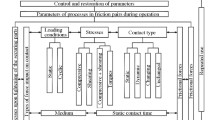Abstract
The possibility of reducing friction torque in face seals is shown based on theoretical and experimental studies. The operational, technological, and constructive means and techniques of reducing the friction torque in face seals are determined. The most economically promising methods for reducing the friction torque are revealed.








Similar content being viewed by others
REFERENCES
Golubev, A.I., et al., Uplotnenie i uplotnitel’naya tekhnika: Spravochnik (Sealing and Sealing Equipment: Handbook), Moscow: Mashinostroenie, 1986.
Falaleev, S.V., Techniques for calculating the hydrodynamic characteristics of mechanical face seals with gaps of complex forms, J. Frict. Wear, 2015, vol. 36, no. 2, pp. 177–183.
Wei, L., Zhang, P., Liu, Q., **, L., and Fang, G., Influencing factors analysis and experiments of friction coefficient between the end faces for contact mechanical seals, Mocaxue Xuebao, 2016, vol. 36, no. 3, pp. 354–361.
Balyakin, V.B., Lavrin, V.B., and Ossiala, V.B.A., Procedure to determine friction torque in a mechanical membrane contact seal, J. Frict. Wear, 2019, vol. 40, no. 1, pp. 46–50.
Yun, F., Wang, L., Yao, S., Liu, J., Liu, T., and Wang, R., Analytical and experimental study on sealing contact characteristics of subsea collet connectors, Adv. Mech. Eng., 2017, vol. 9, no. 4, pp. 1–14.
Balyakin, V.B. and Falaleev, S.V., Study of temperature state of mechanical gas dynamic sealing, J. Frict. Wear, 2015, vol. 36, no. 3, pp. 213–217.
Wen, Q.F., Liu, Y., Huang, W.F., Suo, S.F., and Wang, Y.M., The effect of surface roughness on thermal-elasto-hydrodynamic model of contact mechanical seals, Sci. China: Phys., Mech. Astron., 2013, vol. 56, no. 10, pp. 1920–1929.
Yu, X., Liu, M., Wang, Z., Peng, P., and Cai, R., Experimental investigation on friction performance of mechanical seals with a laser-textured seal face, Mater. Sci. Forum, 2006, vols. 532–533, pp. 81–84.
Müller, H.K. and Nau, B.S., Fluid Sealing Technology: Principles and Applications, New York: Marcel Dekker, 1998.
Young, L.A., Key, B., Philipps, R., and Svendsen, S., Mechanical seals with laser machined wavy SiC faces for high duty boiler circulation and feedwater applications, Lubr. Eng., 2003, vol. 59, no. 4, pp. 30–39.
Author information
Authors and Affiliations
Corresponding author
Additional information
Translated by S. Kuznetsov
About this article
Cite this article
Balyakin, V.B., Falaleev, S.V. Methods and Means of Reducing Friction Torque in Face Seals. J. Frict. Wear 41, 447–452 (2020). https://doi.org/10.3103/S1068366620050062
Received:
Revised:
Accepted:
Published:
Issue Date:
DOI: https://doi.org/10.3103/S1068366620050062




